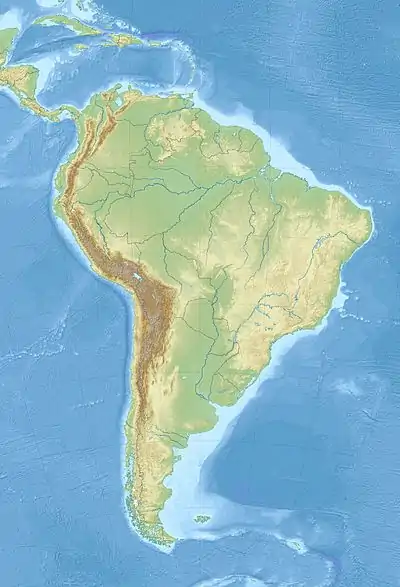1922 Vallenar earthquake
The 1922 Vallenar earthquake occurred with a moment magnitude of 8.5–8.6 and a tsunami magnitude of 8.7 in the Atacama Region of Chile, near the border with Argentina on 11 November at 04:32 UTC.[3][4][1][2] It triggered a destructive tsunami that caused significant damage to the coast of Chile and was observed as far away as Australia.
 | |
| UTC time | 1922-11-11 04:32:51 |
|---|---|
| ISC event | 912062 |
| USGS-ANSS | ComCat |
| Local date | 10 November 1922 |
| Local time | 23:53 |
| Magnitude | 8.5–8.6 Mw,[1] 8.7 Mt [2] |
| Depth | 70.0 km (43 mi) |
| Epicenter | 28.5°S 70.0°W[3] |
| Areas affected | Chile, Argentina |
| Tsunami | Yes |
| Casualties | Several hundred |
Tectonic setting
The earthquake took place along the boundary between the Nazca and South American tectonic plates, at a location where they converge at a rate of seventy millimeters a year.
Chile has been at a convergent plate boundary that generates megathrust earthquakes since the Paleozoic (500 million years ago). In historical times the Chilean coast has suffered many megathrust earthquakes along this plate boundary, including the strongest earthquake ever measured. Most recently, the boundary ruptured in 2010 in central Chile.[5]
Damage and deaths
The earthquake caused extensive damage in a zone extending approximately from Copiapó to Coquimbo. Newspapers estimated more than 1,000 dead as a result of the quake, at least 500 of them in Vallenar.[6] The tsunami killed several hundred people in coastal cities, especially in Coquimbo.[3]
Total damage was estimated to be in the range of $5–25 million U.S. (1922 dollars).[3][7]
Characteristics
Earthquake

The earthquake was preceded by strong foreshocks on 3 and 7 November. The main shock lasted between thirty seconds and eight minutes according to various reports.[8]
The length of the plate boundary that ruptured during the earthquake is estimated to be 390 km (242 mi).[9]
Tsunami
The epicenter of the earthquake was well inland and the tsunami may have been caused by a submarine slide triggered by the shaking.[10]
At Caldera the tsunami began about 15 minutes after the earthquake, with a maximum run-up height of 7 m (23 ft). At Chañaral the tsunami had three surges, the first about an hour after the earthquake, the maximum run-up height was 9 m (30 ft). Three surges were also seen at Coquimbo, the last being the most destructive with a maximum run-up of 7 m (23 ft).[9]
The tsunami was also observed in Callao, Peru (2.4 m, 7.9 ft), California (0.2 m, 8 in 13.0 hours delay), Hawaii (2.1 m, 6.9 ft 14.5 hours), Samoa (0.9 m, 3 ft 14.1 hours), Japan (0.3 m, 1 ft), Taiwan (0.03 m, 1 in), New Zealand (0.1 m, 3.9 in), Australia (0.2 m, 7.9 in)[11] and the Philippines (0.1 m, 3.9 in).[8]
References
- Carvajal, M.; Cisternas, M.; Gubler, A.; Catalán, P. A.; Winckler, P.; Wesson, R. L. (14 December 2016). "Reexamination of the magnitudes for the 1906 and 1922 Chilean earthquakes using Japanese tsunami amplitudes: Implications for source depth constraints". Journal of Geophysical Research. 122: 4–17. doi:10.1002/2016JB013269. S2CID 132901262. Retrieved 25 August 2022.
- Abe, Katsuyuki (1979). "Size of great earthquakes of 1837–1974 inferred from tsunami data". Journal of Geophysical Research. 84 (B4): 1561–1568. Bibcode:1979JGR....84.1561A. doi:10.1029/JB084iB04p01561. Retrieved 8 August 2022.
- USGS, Historic Earthquakes.Chile-Argentina Border. 1922 November 11 04:32 UTC. Magnitude 8.5
- Seismological Notes, Bulletin of the Seismological Society of America. "Seismological Notes" is a list of recent important earthquakes with short summaries included in each issue of the BSSA.
- USGS (6 March 2010). "Magnitude 8.8 – OFFSHORE MAULE, CHILE". Archived from the original on 1 March 2010. Retrieved 6 March 2010.
- "Thousands Die in Earthquake." Tulsa (OK) World, 13 November 1922, p. 1.
- Dunbar, Paula K., Lockridge, Patricia A., and Whiteside, Lowell S., 1992, Catalog of significant earthquakes 2150 B.C. – 1991 A.D.: U. S. Dept. of Commerce, National Oceanic and Atmospheric Administration.
- NGDC. "Comments for 1922 tsunami". Retrieved 6 March 2010.
- SHOA (Servicio de Hidrográfico y Oceanográfico). "Tsunamis registrados en la costa de Chile" (PDF) (in Spanish). Archived from the original (PDF) on 22 February 2016. Retrieved 6 March 2010.
- Gutenberg, B. (1939). "Tsunamis and earthquakes". Bulletin of the Seismological Society of America. 29 (4): 517–526. Bibcode:1939BuSSA..29..517G. doi:10.1785/BSSA0290040517. Archived from the original on 6 September 2008. Retrieved 6 March 2010.
- "Effect on Australian Tides". The Sydney Morning Herald. 1922. p. 9. Retrieved 25 November 2013.
External links
 Media related to 1922 Vallenar earthquake at Wikimedia Commons
Media related to 1922 Vallenar earthquake at Wikimedia Commons- The International Seismological Centre has a bibliography and/or authoritative data for this event.